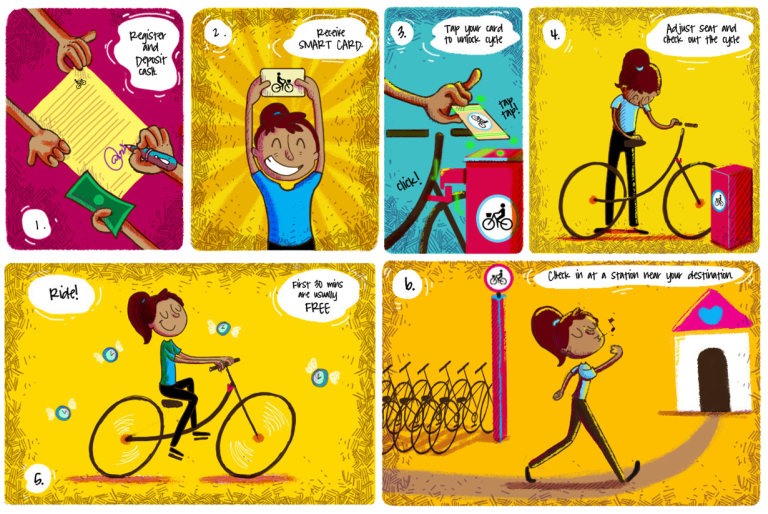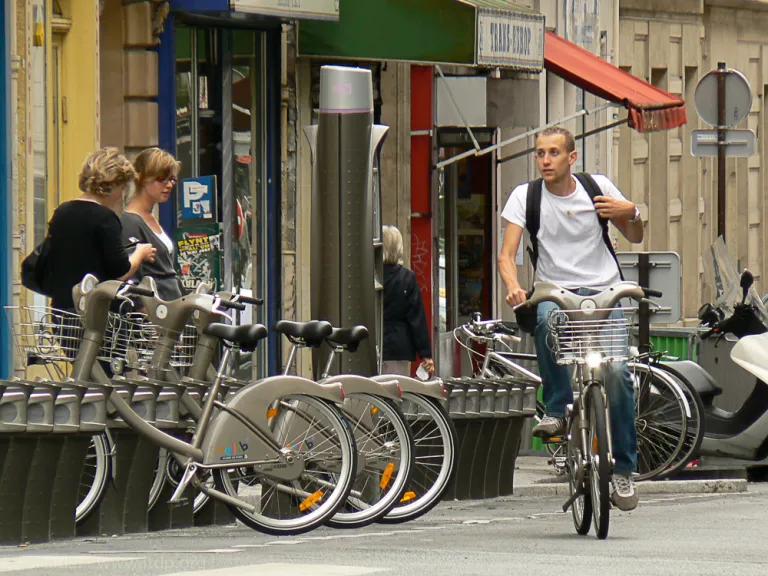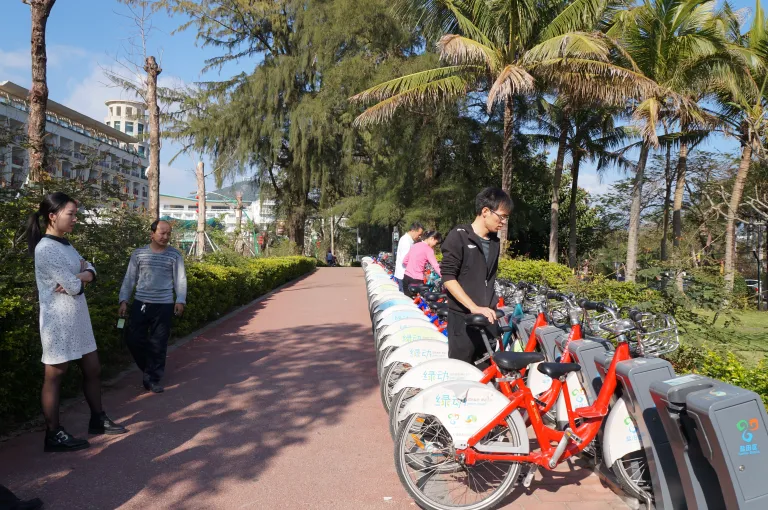(With excerpts from a toolkit developed by the author for the Ministry of Urban Development, Government of India) When it comes to public cycle sharing systems, India doesn’t need to look too far. China, in just under a decade, has outpaced European cities that gave birth to the idea half a century ago. Today, all but four of the 20 largest systems in the world are in China—ranging from 8000 to 80000 shared cycles. Unfortunately, India has none.
Written by unknown
Written by unknown
What is cycle sharing?
Cycle sharing is a healthy, non-polluting, and flexible form of personal public transport—a great option for short trips and as a feeder to other public transport options. Cycles are securely stored (or docked) at a closely spaced network of stations. With a smart card or another form of identification, a user can check out a cycle from any station, use it for a short ride, and return it at any other station of the system. For a small membership fee (annual/monthly/daily), users can make unlimited free trips, as long as they return the cycle within a stipulated time (typically capped at 30-45 minutes).

Is cycle sharing a new concept?
Not really. It started as an experiment half a century back in Amsterdam with fifty cycles. Since then, the idea has evolved and expanded while retaining the basic essence. Advances in information technology gave a big boost to the idea and led to a massive growth in the last decade. Today, there are over 1.3 million shared cycles in over a 1000 cities around the globe. More systems are starting every year. Cycle sharing has demonstrated its ability to re-energize cycling—transforming the image of cycles from lowly tool to cool mode. In many cities, it has also led to the creation of large networks of safe cycling facilities.

Where does one start?
Above everything else, cycle sharing requires political will and policy support to succeed. Some of the largest and most successful cycle sharing systems in the world—such as those in Paris, London, and New York—are a result of active championing by the mayors of those cities. London’s hugely popular cycle-sharing scheme is a result of two of its former mayors, Ken Livingstone and Boris Johnson, who were determined to increase cycling in London.
The London story also gives us insights on the best way to implement a cycle sharing programme— through public-private partnership. While the London scheme is overseen by the city’s transport department, Transport for London, it is sponsored by Santander Bank (originally sponsored by Barclays) and operated by SERCO, a private company, on a six-year contract with service level benchmarks. The system that started with 5000 cycles in 2010 has expanded to 11,500 cycles today, serving 5-7 trips per cycle everyday.
Successful implementation of a cycle sharing system requires meticulous planning and oversight on the part of the government. Private sector participation can bring several advantages, including access to capital and technical expertise. But, constant oversight by the public implementing agency is necessary to ensure that the system meets high service quality standards. The contracting structure should create the right incentives by rewarding good work and penalising poor performance. In order to evaluate the operator’s performance, the implementing agency needs access to real-time system data.
User leaving after unlocking a cycle from an automated docking system in Paris, France.

What are the features of a good system?
To begin with, a system should have at least a 1000 cycles with a coverage of five square kilometres or more. Anything smaller is unviable and almost always fails. For instance, Smartbike DC in Washington DC failed to exist with ten stations and 120 cycles. It shut down in a year. Capital Bikeshare replaced it successfully with 1100 cycles connecting a 100 stations. Today, the system has three times as many stations and 2500 cycles. The most successful systems have over 5000 cycles; the largest ones have even more. The system in Hangzhou, the world’s largest, has over 80000 cycles.
Cycle sharing stations should be spaced closely—in a grid of 300m or less—so that users can get a-near-doorstep service. A fully automated system removes the need for staffing at a station. The number of docks in a system (where cycles are locked) is 1.5 to 2 times the number of cycles in operation. A typical station has 12-15 docks. Stations at some important locations, like public transport terminals, can be larger, with 30-50 cycles placed inside an enclosure, accessed through one or more automated control gates.
Technology plays a key role in cycle sharing—from safeguarding cycles from theft, to giving real time information to users as well as operators. Chips embedded in a smart card or tag (issued at the time of registration) allow users to unlock cycles from automated stations and docking points. Users get information on station location as well as availability of cycles through web based portals and mobile applications. Operators use the data collected to redistribute cycles from saturated stations to empty ones to ensure availability at all locations. Data also helps in planning future expansion of the system.
The overall appearance of the cycle is a key element in the branding of a cycle sharing system. It should project a sleek, modern image. Cycle should have specially designed parts and sizes to discourage theft. Operators must conduct regular and frequent maintenance of cycles. A cycle with a flat tyre or a broken chain is of no use. Users should be able to notify an operator if a cycle needs repair with just a push of a button at a station. For instance, the maintenance team should clean the cycles and inflate tyres every alternate day. Once every fortnight, things like drive chain lubrication and functioning of brakes should be checked. Once a year, a full overhaul is recommended.
The most successful systems have over 5000 bicycles, like at this docking point in Shenzhen, China.

What cycle sharing is not
Cycle sharing is often confused with cycle rental systems. Cycle sharing is a technology-based self-service system that differs in significant ways from the traditional commuting or tourism-oriented rental services that are present in many parts of India. Shared cycles give the user flexibility to pick and drop a cycle at any station, encouraging short trips and providing last mile connectivity. Rentals are small scale businesses with pricing models that encourage longer trips. Users have to return the cycle where they picked it up from.
Cycle sharing systems are also not a replacement for large-scale cycle distribution schemes. These programs, generally aimed at rural users, have a strong focus on poverty alleviation. It is important to recognize that cycle sharing is not necessarily for the poorest of the poor, but an alternative for short trips done by paratransit, bus, or walking. Many low-income residents already own and use cycles because they cannot afford to use any other mode, even public transport. A critical aim of cycle sharing is to attract new users who would not otherwise use cycles. By broadening the cycle user base and raising the profile of cycling in a city, cycle sharing can build a constituency for improved cycle infrastructure, which benefits all cyclists, rich and poor alike.
What is the future of cycle sharing in India?
Over the past decade, there have been over a dozen experiments—all of them very small in size—in various parts of India. Some were non-profit enterprises; others were commercially driven. Many were, at best, cycle rentals; others were just advertising contracts in the garb of cycle sharing. It would be a fair to say that there is not a single shared cycle in operation in India at present.
In 2012, on behalf of the Ministry of Urban Development (Government of India), the Institute for Transportation and Development Policy (ITDP) prepared a planning toolkit for India cities on public cycle sharing systems. The Ministry has been actively encouraging cities to adopt this idea. A positive sign is the large number of cities that were selected in the first round of the India Smart Cities Challenge identified cycle sharing as a key initiative in their proposals.
Cycle sharing is an idea whose time has come in India. Many Indian cities are at an advanced stage of planning, or even implementation. According to calculations by ITDP, the top hundred Indian cities should have invested by the year 2031 in over over six hundred thousand shared cycles—along with many other sustainable transport facilities—to become truly smart. It remains to be seen if India will emulate the success of its neighbour, China!
The article was first published in Urbana World, May-Jun 2016.
The overall appearance of the cycle is a key element in the branding of a cycle sharing system.



